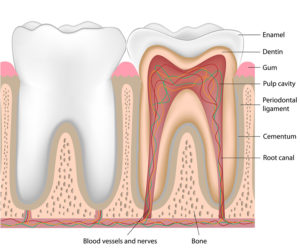Family Dentist in Newport News, VA
 Dental development starts from approximately the 6th week in pregnancy through late adolescence. It involves the formation, eruption, and shedding of the 20 primary deciduous teeth, as well as the formation and eruption of the 32 permanent teeth. Throughout this development, the teeth are subject to both genetic and environmental influence.
Dental development starts from approximately the 6th week in pregnancy through late adolescence. It involves the formation, eruption, and shedding of the 20 primary deciduous teeth, as well as the formation and eruption of the 32 permanent teeth. Throughout this development, the teeth are subject to both genetic and environmental influence.
In addition to their role in speech and facial aesthetics, the teeth provide a system of mastication with incising, tearing, and grinding capabilities. The structure of teeth allows them to survive the forces and wear of mastication. Therefore, changing in the composition or structure of the teeth affects their durability and resistance to fracture.
Each tooth has a visible crown that projects above the gum, with one or more roots extending into the alveolar bone of the maxilla or mandible. The crown and root meet at the neck of the tooth. The tooth forms a peg and socket joint with the alveolar bone and is held in place by a membrane that allows slight movement of the tooth.
Four components of teeth are:
- Enamel
- Dentin
- Pulp
- Cementum
Enamel
Dental enamel is the hardest tissue in the human body. It protects the tooth crown from fracture and wear. The enamel is produced by cells called ameloblasts. Because the ameloblasts are no longer present once the tooth is fully formed and erupted, dental enamel has no regenerative capacity.
By weight, normal dental enamel is 96 percent mineral, 2 percent water, 1 percent protein, and 1 percent other components. The structure of enamel provides its strength and resistance while making it less brittle. Changes in the mineral, water, or protein content of enamel alter its appearance, strength, and resistance to wear and caries.
Dentin
Dentin is the most abundant dental tissue. It functions as the substructure for the enamel and largely determines the size and shape of teeth. Dentin is produced by the dental pulp. The production of dentin is increased in response to environmental stimuli such as trauma, tooth wear, or caries.
By weight, dentin contains about 60 percent mineral and 20 percent organic components, including protein. The structure and composition of dentin give teeth the ability to flex and absorb tremendous functional loads without fracturing.
Pulp
The dental pulp is a specialized tissue made of odontoblasts, which are dentin-producing cells, fibroblasts, blood vessels, nerves, and a complex matrix. It provides the neurosensory function. The pulp continues to produce small amounts of dentin throughout the life of a tooth. Maintaining a healthy dental pulp until the root of the tooth is fully formed and has walls thick enough to sustain the forces transmitted from the crown during mastication is important. Prompt and appropriate treatment of dental trauma and caries in children is critical to the sustenance of oral health.
Cementum
Cementum is made of type I and other collagens, proteins, and a mineralized matrix. It covers the root surface and helps to prevent the tooth from becoming fused to the adjacent alveolar bone. It is structurally similar to bone. In addition, cementum provides the tissues by which the tooth is anchored to the periodontal ligament and the alveolar bone. These structures form a flexible sling that holds the tooth in place while allowing the movement necessary under the forces required for chewing.
12821 Jefferson Avenue
Newport News, VA 23608


